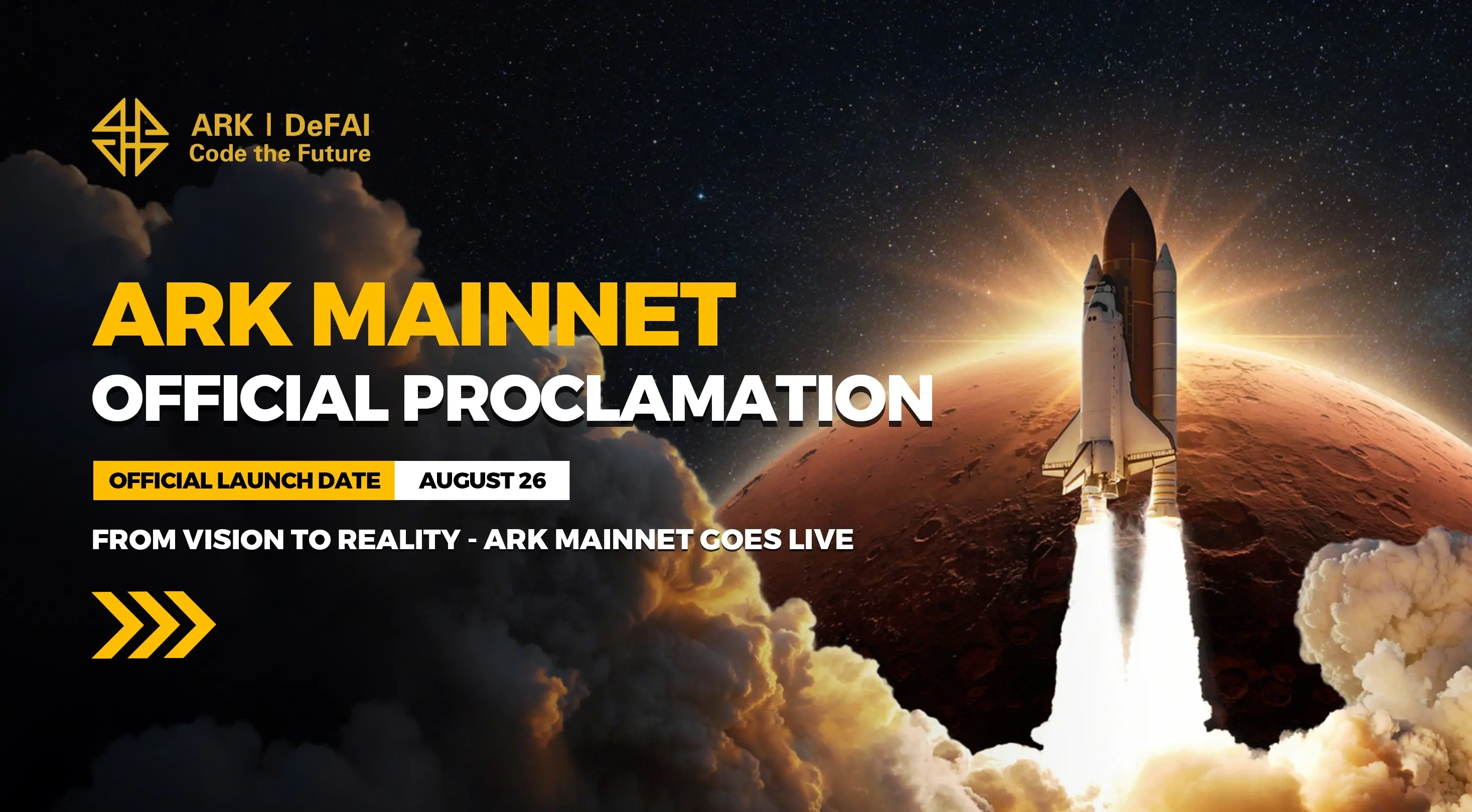ARK mainnet officially launched: DeFAI protocol sets sail
This symbolic initiative allowed global investors and developers to witness the birth of the first DeFAI protocol civilization driven by AI algorithms and DAO co-governance.
The combination of decentralized finance and artificial intelligence has officially ushered in a historic moment. ARK (Ark Realm) announced the official launch of its mainnet, completed the genesis liquidity injection, and permanently destroyed the LP tokens. This symbolic move allowed global investors and developers to jointly witness the birth of the first DeFAI protocol civilization driven by AI computation × DAO co-governance.
This is not just the birth of a protocol, but the beginning of a decentralized civilization.

ARK DeFAI—From DeFi to Civilization Experiment
Over the past five years, DeFi swept the market with its innovation speed, bringing concepts such as Automated Market Makers (AMM), Protocol Owned Liquidity (POL), and algorithmic stablecoins. However, it also fell into stagnation due to uncontrolled inflation, low governance efficiency, and protocols being overly reliant on faith.
The birth of ARK is a "new species" in this context.
- DeFAI = DeFi + AI ARK positions itself as a fusion track of decentralized finance and artificial intelligence. It not only inherits the mechanism experiments of financial protocols but also introduces AI-driven computational decision-making into governance and policy modeling, endowing the protocol with adaptive and evolutionary capabilities.
- Protocols are not tools, but nations. In ARK's design, users are no longer just "investors" or "liquidity providers," but citizens (ARK Citizen) with identity and behavioral weight. The underlying narrative of ARK is no longer simply a financial track, but a social experiment aiming for "protocol civilization."
In this sense, ARK has pioneered a new trajectory: it is not just an extension of DeFi, but the first protocol system in the Web3 world positioned as a "civilization."
Five Core Modules × Dual Support × AI Computation
The core innovation of ARK lies in its modular + AI governance approach, reconstructing the institutional logic of financial protocols.
Five core regulatory modules
- EM (Emission Manager | Intelligent Token Issuance Module)
- RBS (Range Bound Stabilizer | Market Cap Stabilization Module)
- YRF (Yield Revenue Feedback | Revenue Buyback Module)
- MCL (Mint Cap Limit | Minting Cap Monitoring)
- RCM (Runway Control Module | Operational Cycle Monitoring)
Dual economic support
- POL (Protocol Owned Liquidity): Prevents "rug pulls" and ensures liquidity depth.
- ATS (Ark Treasury System): The treasury acts as the economic artery, supporting the overall protocol's stability and value feedback.
AI Computational Consensus Layer
The AI computational layer of ARK is responsible for market forecasting, policy simulation, and governance recommendations. AI does not vote, but its role is that of a neutral advisor and risk forecaster, allowing governance to transcend emotion and delay.
Background: Endorsement by Top Institutions and Experts
The design of ARK is not a castle in the air, but is built on the support of international investment funds and top-tier experts.
- Morgan Crest Web3 Foundation
- Founded by descendants of the Morgan family and Silicon Valley private equity giants, headquartered in New York.
- Has invested 30 millions USD to promote AI × Web3 infrastructure, with ARK listed as one of the core investment projects.
- Its investment portfolio also includes Lido Finance, FRAX, Berachain, Bittensor, and others.
- Carmelo Ippolito—Member of the ARK DAO Co-construction Committee
- Globally renowned DeFi architect, early participant in the initial design of Olympus DAO.
- Led the ARK intelligent governance architecture and is known as the "soul figure of ARK."
- In 2024, he was interviewed by Forbes, affirming his forward-looking insights in the AI × DAO field.
Looking Ahead: From Protocol to Civilization
The plan for ARK is a ten-year blueprint for civilizational evolution:
- 2025–2026: Complete mainnet and core module deployment, launch DAO governance.
- 2027–2028: Open the ARKLand model society, covering five major AI module layers: financial governance, education, health, social, and creation.
- 2029–2030: Launch decentralized identity (ARK Passport) and governance cities (ARK Zones).
- 2031–2032: Achieve AI self-iterative governance and launch a global governance index.
- 2033–2035: Initiate MetaCiv federal civilization, building cross-chain nations and a global charter.
ARK, Not a Protocol, but the Starting Point of Civilization
In the past decade of the DeFi wave, protocols have risen and fallen, with countless mechanisms born and vanished.
But in ARK, what we witness is not just another protocol, but the origin of a digital civilization.
ARK not only reshapes financial mechanisms but also ignites the spark of decentralized civilization.
Its launch is not a call for speculation, but a testing ground for systems and order:
- Every address is a citizen
- Every action is a signal
- Every contribution is the gene of civilization
- Every decision is the advancement of history
The birth of ARK turns tokens into constitutions, contracts into systems, and participation into civilization. ARK is not just a protocol, but the beginning of a decentralized civilization.
Disclaimer: The content of this article solely reflects the author's opinion and does not represent the platform in any capacity. This article is not intended to serve as a reference for making investment decisions.
You may also like
Bitcoin due 2026 bottom as exchange volumes grind lower: Analysis

samczsun: The Key to Crypto Protocol Security Lies in Proactive Re-Auditing
Bug bounty programs are passive measures, while security protection requires proactive advancement.

Millennials with the most cryptocurrency holdings are reaching the peak of divorce, but the law is not yet prepared.
The biggest problem faced by most parties is that they have no idea their spouse holds cryptocurrency.

Using "zero fees" as a gimmick, is Lighter's actual cost 5–10 times higher?
What standard accounts receive from Lighter is not free trading, but rather slower transactions. This delay is turned into a source of profit by faster participants.

